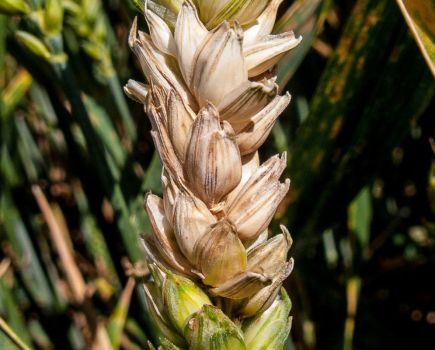Advanced chlorophyll enhancing technology backed by science and proven in the field, is now making its way through European CE validation and looks set to shake up the UK biostimulant market. CPM finds out more.
“We haven’t really seen anything like it before.”
By Charlotte Cunningham
Though biostimulants in varying forms have been part of crop production strategies for quite some time, the spike in interest over recent years has led to a flush of new products coming onto the market – with mixed performance.
However, the development of new chlorophyll enhancing technology, based around the novel molecule biostimulant MTU, looks to be a groundbreaking new offering for growers.
The molecule was first discovered in 2013 by scientists at the Institute of Experimental Botany, part of the Academy of Sciences of the Czech Republic. Research scientist Dr Jaroslav Nisler says he knew something very special had been discovered after the first tests.
“Young wheat leaves cut from growing plants and immersed in a weak solution of MTU were still green after five days in total darkness, while the control ones in just water were showing significant and irreversible signs of senescence.
“Injury from the clipping process and lack of light are usually enough to induce chlorophyll breakdown in leaves, and water does little to slow down the yellowing and tissue deterioration associated with this process, but the MTU was obviously doing something special.”
So how exactly does it work? MTU, or 1-(2-methoxy-ethyl)-3-1,2,3-thiadiazol-5-yl urea to give it its full name, is a single molecule which increases phytochrome activity, making plants more sensitive to light in the red and far-red region. The greater the light absorption, the greater the photosynthetic pigment content in the plant leaves.
Not only is the photosynthetic pigment increased, but MTU also protects the photosynthetic apparatus, which subsequently slows down the natural degradation of chlorophyll in plant cells.
“Chlorophyll in plants is constantly being rebuilt,” explains Jaroslav. “The half-life of chlorophyll is from one to a few days, so new molecules are constantly being rebuilt to keep the plant productive and healthy.
“If you can block the degradation of chlorophyll without slowing down its synthesis, levels build up in the plant as old molecules remain in the cells while new ones are made.”
Now after 10 years of development, trialling and fine-tuning to establish how to use MTU to best effect in the real world, it’s creating real excitement among agronomists and crop physiologists alike, with many describing it as genuinely groundbreaking, notes Jaroslav.
“We haven’t really seen anything like it before. The fact that MTU achieves the results it does at dose rates of just 0.5g/ha underlines just how unique it is.”
In trials to date, researchers have seen MTU increase chlorophyll levels by as much as 20%. “The more chlorophyll there is, the greater the rate of photosynthesis, the more CO₂ assimilation takes place, the more sugars are produced and the healthier the crop is,” he explains.
“The process also improves nitrogen use efficiency by increasing the critical carbon to nitrogen ratio in the plant, as well as building the resilience required to deal with the greater abiotic stresses now increasingly experienced in crop production.
“In trials with wheat, leaves exposed to periods of drought, heat or salinity, for example, those treated with MTU remain green for longer and recover much better after rewatering or when the stress is removed.”
But if what’s happening to the plant above the ground is impressive, what’s taking place below the ground is even more striking, says Jaroslav.
“MTU is a very weak cytokinin and while cytokinins generally inhibit primary root growth, MTU appears to work on one specific receptor, and this actually encourages plants to build bigger roots,” he explains. “MTU therefore provides the benefits of cytokinins, such as anti-senescence properties and reduction in the effects of stress, without their negative effects on root growth.”
In ideal conditions, while stem growth can be 10% above the ground with MTU, this can be as much as 20% when looking at the roots. However in conditions of stress, such as drought or excessive heat, additional root growth can be as high as 40%, he adds.
Such results have piqued the interest of UK biostimulant specialists IntraCrop, with the company working closely with Jaroslav and the Czech Academy of Sciences during the past eight years to bring the concept through to market.
“A key part of this has been to bring MTU and its associated products through the appropriate regulatory framework and ensure it’s recognised as a bona fide product for growers with proven results and quantifiable benefits,” says IntraCrop’s Emily Way. “It’s already a patented product with a lot of independent work published on it, but we really want to make sure the science, the trials and the knowledge around MTU stack up 100%.
“There are currently no regulations for biostimulants in the UK and they don’t even have to be authorised or registered anywhere as long as they don’t claim any direct effect on pests or diseases,” she says.
Emily explains that Europe is ahead in this respect following the implementation of the Fertilising Products Regulation which now includes biostimulants, subjecting them to a stringent review of claims before a CE mark can potentially be granted.
“We’re currently aiming for conformity assessment for the CE mark under this new regulation with claims around yield, quality, stress reduction and nitrogen use efficiency hopefully permitted.
“Defra is also undergoing a stakeholder consultation to overhaul the existing UK regulations and we’re very much part of this process. Indications are the old rules will be replaced with controls for biostimulants introduced in the next few years.
“The real beauty of MTU in all this is that it’s a single molecule that can be clearly identified, and its specific mode of action is understood. This means we can clearly define a dose rate for it with realistic expectations of what it can deliver in the field.”
Keen to prove the efficacy of MTU on UK soils, IntraCrop’s own trials have revealed similar results to those in Europe.
“Improvements in chlorophyll production and photosynthetic activity typically range from 20-50% depending on circumstances, and this translates into yield benefits of 5-20% — with the more the stress on the plant, the greater the response to MTU,” notes Emily.
“We’ve seen particularly interesting results by using a combination of MTU and pidolic acid, with both types of chemistry seeming to complement each other very well.”
MTU has a proven effect on chlorophyll levels, while pidolic acid helps to increase nitrogen assimilation in plants, she explains. “This was shown in winter wheat trials at Poznan University in Poland, which revealed a yield response of up to 25% when this combination was applied at GS 32-33.”
The MTU and pidolic acid combination has also delivered impressive results in other crops, adds Emily. “We’ve seen fantastic results with sunflowers in Hungary and trials in Cambridge with sugar beet have shown a root weight increase of 11t/ha — up from 57.19 to 68t/ha — worth an extra £418/ha at the time of the trials.
“All in all, we’re really excited about what MTU brings to crop production — whether it’s broadacre agriculture or more specialist areas such as vegetables and other crops.
“As weather extremes become more prevalent, abiotic stress on crops will increase and MTU’s mode of action can help mitigate this in so many different ways whether it’s reducing the effects of stress, making better use of nitrogen, or delivering higher yields from less inputs.”
This article was taken from the latest issue of CPM. Read the article in full here.
For more articles like this, subscribe here.
Sign up for Crop Production Magazine’s FREE e-newsletter here.




